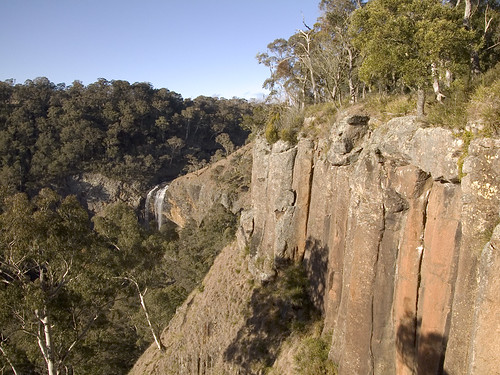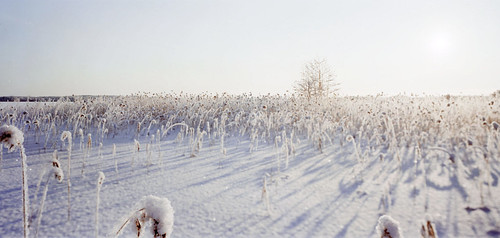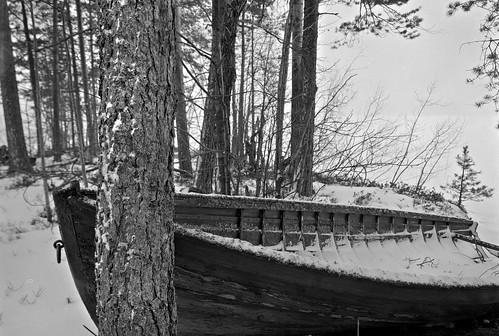As I was recently contacted by someone with some questions about the camera now seems as good a time as any to consider putting together my thoughts and impressions after ten years of use.
If you're not familiar with the camera, Kerry Thalmann has done a great review some ten years ago on his pages here. His images and descriptions cover so much more and in such a logical flow that I would not be tempted to try to redo that. I recommend you read that if you don't know the camera, as it will help you to make more sense of the images of the camera I present here.
Instead what you'll find here are some of my thoughts and findings of the camera after taking it with me through several countries and quite a diverse shooting environment.

and a diverse range of photos (mainly landscape). I've used it out on lake shores in Finland in -25°C with chilling winds...

and in harsh Australian inland summers. Through all this the camera has proven to be a robust and reliable device. I can honestly say that in the years of ownwership nothing has gone wrong with the camera.
Two things attracted me to the Toho in the first place:
- it was light
- there were no reasonable restrictions to movements (it being a rail camera)
The first thing is complexity. Being a extending rail camera with tilts and shifts on both front and back there are knobs every bloody where. This is something that you may find confronting, but with discipline everything falls into place.
On this point I'll raise two items; many years ago I started studying Akikdo, and I'm left handed. You may ask what this has got to do with anything here, but the significant point is this:
you need to learn to do everything according to a system and apply a strict discipline to what you do. This is not to get in the way of creativity, but to free you from the confusion of needing to think about every move you make. Secondly as a left hander next to nothing is made to work in a way that feels natural. So you have to spend time with everything to get used to it.So with the above declaration of nothing going wrong in mind I thought I would focus on the issues that I have come to know and understand on the camera ... which are essentially few.
Even with Kerrys fine pictures I thought I would introduce the camera as it will look to you on the tripod.
The camera has two separable parts, the rail and the camera itself. The bellows is the essentially permanently attached to the front and rear "standards" of the camera.
As I said, my camera didn't come with a bag, but I thought that I'd get something nicely made from a canvas shop, in water resistant canvas ... cos I go out in the rain. If you live somewhere humid do not store the camera in this kind of bag, you are just inviting fungus to invade your bellows and ruin them. The same goes with your lenses. Store them in a dry place ... there are lens cabinets which de-humidify the air, alternatively use a sealed plastic container with some products like the potassium hydroxide based ones. DO NOT USE ANY SCENTED TYPES.
Then with the rails on the tripod we can get a look at these, their size and how the rails extend.
Next, putting the "body" onto the rails
The next issue is then making adjustments. If you look over Kerry's images of the camera you may not really grasp how fine the tolerance of the camera rails are. They are essentially sections of alloy which are dovetail wedge shaped to slide in and among each other. So the rail extensions look like this:

and the support arms for the front and back of the camera look like this:

As you can see, a wedge essentially presses into the dovetail and locks it in place.
and mounted look like this:

What this means is that with weight on the mounts (like having the camera mounted on the rails) things require a little assistance to move up and down ... You can see the anodizing wearing off on the inside of that rear support there from movement, but this has little real impact on anything.
So essentially its better to support the end you're moving with one hand undo the clamp knob a little, slide it up, then tighten down.
For kiddes who can only drive a mouse, a playstation or a plastic digital camera this will represent problems (as I see many can't even mount or unmount 35mm lenses without going into some sort of panic). Its not a problem to me, but it can lead you to think that something is tightened down properly when its not.
You'll notice in the videos that I tend to 'wibble' things as I'm moving them and tightening down ... this helps you to overcome friction and make sure the moving surfaces meet and tighten down properly.
Perhaps you'll see what I mean in this video where I show moving some of the cameras joints for tilt / shift / rise and fall
again, discipline is your friend, do things methodically and you won't have any problems.
If this is sounding like a hassle, then clearly LF is not for you.
Putting a lens on the camera
The Toho has a circular lens board, which is quite unique. I find that its easy to mount, and if you mount it top in with the bottom secured last, you won't get any nasty surprises of the lens falling out when you didn't expect it.
So for example I can rotate the lens to put the shutter release on either side (depending on which side I wish to work on .. there could be for instance a cliff on the other side of my tripod as there was here.

Note the order that I put the lens on in. Top clamp first bottom clamp second.
The camera uses rear focus, personally I prefer this as particularly with macro you don't get the lens moving around relative to the subject when focusing:
This is a good time to mention the nylon washers I added. I thought that the original ones were not compatible with the fact that both the locking crown and the base were anodized alloy. I didn't like the lack of 'feel' and thought that the nylon would be smoother to tension down and as it compresses a wee bit more than metal give a little better 'feel' to tightening down. You can see them in the above close up pictures if you look at them again.
Film handling
The Toho has a "universal back" which is essentially a flap with the focusing screen in the middle and all on a hinge to allow you to insert film holders and even roll film backs.
As you can see below, putting in a double dark (which holds 2 sheets of film, one on each side) is a peach
but putting on a roll back without a Graflok back is a little more annoying.
It pisses me that my Canon A520's video cuts out at the times it does .. what I was saying is that you can't see the film advance counter on the roll back. Essentially the problem is that with a Graflok back you'd be taking off the ground glass and then clamping on the film holder. While the advantage of the universal back is that I don't need to take the screen off out in the field (where you then have to have somewhere to put that screen, not down in the mud) when you put your film holder on the camera. However it means that the screen now does not block your view of the holders back, and for many roll backs this is something which is important. You need to see the back to advance the film and read off the counters.
So essentially I can take one picture then I have to pull out the back to wind on for the next. Annoying if you're wanting to bracket ... however in reality now that I use a digital as my light meter I get my exposures perfect each time (and I use Neg mostly which is more forgiving than chromes).
This image was taken with the 120 roll back in 6x12

Having both the roll back and the 4x5 holders is nice, but brings me back to wonder about weight.
Light Weight
Well you see with film holders, light meter (my G1), tripod and lenses it works out that the light weight of the Toho is not such an advantage as you might think. Still, its always nicer to have less in the pack ... right? If taking lots of images then clearly the roll back and a few rolls will weigh less than a bunch of double darks: 180g for a Lisco holder vs 680g for my roll back. I can take 6 images on a roll of 120 with the 6x12 which is 3 darks. Still, its not always as easy as that, sometimes I don't want the wide format but do want the larger area of the 4x5 sheet (meaning I don't want to crop off the edges of 6x12s).
I sometimes go armed for a weekend with 10 holders and a few rolls of 120 ... still, if I'm doing a days packing I'll try to trim that down ....
But its not only about weight, as the Toho has some advantages in setup and carrying.
If you refer to Kerry's picture (Fig2 - disassembled for transport ) I often take my camera apart and leave the rails on the tripod and put the body back into its carry bag.
Clearly if you're going a long way it may be annoying to leave the rails on the tripod, but for packing into the car or just a few km hike I leave it on the tripod and sling the tripod off the side of my pack.
But don't under estimate the advantages of leaving your rails locked where you used them last. I've moved to another place to find that my last set of tilts worked out really close to my next set. Not to mention that it can make changing focal lengths (lenses as there's no zooms) easier with often exactly the same back tilt needed and just the rails extended.
Summary
all in all the Toho has been a great tool, nothing I have beats 4x5 black and white for tonals and if you get the focus right (and nothing moves) then detail is equal to the best in digital.
Would I recommend it? Sure, if you're after a 4x5 then in my opinion it has all the control of anything you can get and all the movments. It does not have interchangeable bellows, but then I've never felt the need for that. The only downside is that you won't get the looks you get from an Ebony ... or is that an upside.
Its compact, tucks away well and very well made. If you're after one, they turn up from time to time on Ebay.
Is 4x5 for you? ... well I can't answer that ... but if you know what movements are and why you may want them

then 4x5 is perhaps cheaper than a bunch of TS-E lenses and a 5DMkII

besides I have a G1 digital too










6 comments:
Great post. I like the very last photo -- very atmospheric. You're convincing me to look into these Toyos.
Thanks for a great write up / vid post.
I know one person with one, and have read all Kerry's info.
How do you find it in the wind? That's my only worry.
By the way Keith, very different to a Toyo ;-)
Phil
wind ... well wind shits every photographer off!
By nature a light bellows camera is going to be disturbed by wind. If its a gentle wind I do the following:
- once focused and checked focus, I strut between front and rear standards with 3 bamboo chopsticks with a blob of blue-tac each end. This reduces the vibrations inherent in the 'cantilever' created by the bottom tilts
- carefully shroud my camera in my dark cloth (which is a ultra-thin silvered-one-side bit of fabric I got from a fabric shop for $6). This 'scarf' then reduces the airflow over the bellows. I tie it off with a small bit of string around the tripod mount.
seems to cope well with light breeze but strong wind ... well that's tough.
I would love to buy this, but it seems to be off the market, and is likely only in the used market. Where would you suggest looking, besides the usual suspects eBay, B abd H used, largeformatphotography.info forum, apug forum?
phillinj located at slu.edu
Nancy
First off let me know if you didn't want this comment published, I will delete it.
Secondly I'd add a bit about eBay to that list. Create a search and save it. That way you can get email when a camera matches your criteria.
Also try Yahoo auctions in Japan too.
However if I had nothing now I would ask myself why I wouldn't just go for a std field camera like a toyo view. Would do me for 90% of my movements and probably be easier to set up.
Dunno, I like the toho but its not without minor annoyances (lie using a roll back would be nicer with a Graflock rather than universal back I suspect)
Thank you. Yes, I can see that for the complete novice, a standard folding field camera might be better to start learning movements. Fewer choices of movements due to fixed or limited back standard might be an advantage at first, simplifies decision making. There are a zillion folders on the market, as well, so I could likely pick up a used bargain. A local photographer is considering selling one of his less-used field cameras, so I could see it demonstrated in person. That, plus an ancient salvaged 150mm Geragon (assuming the shutter works), might be the easy way to start.
Post a Comment